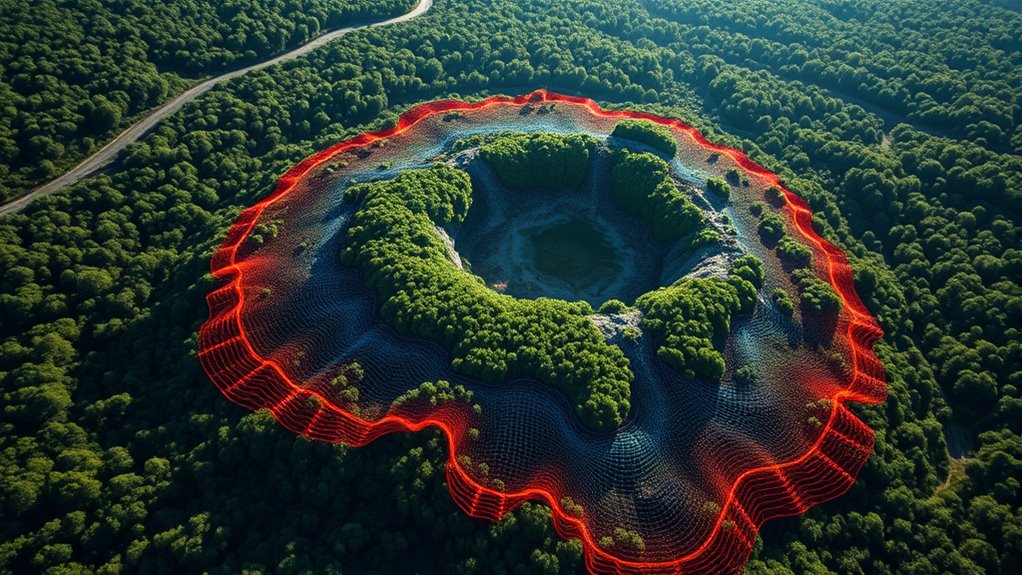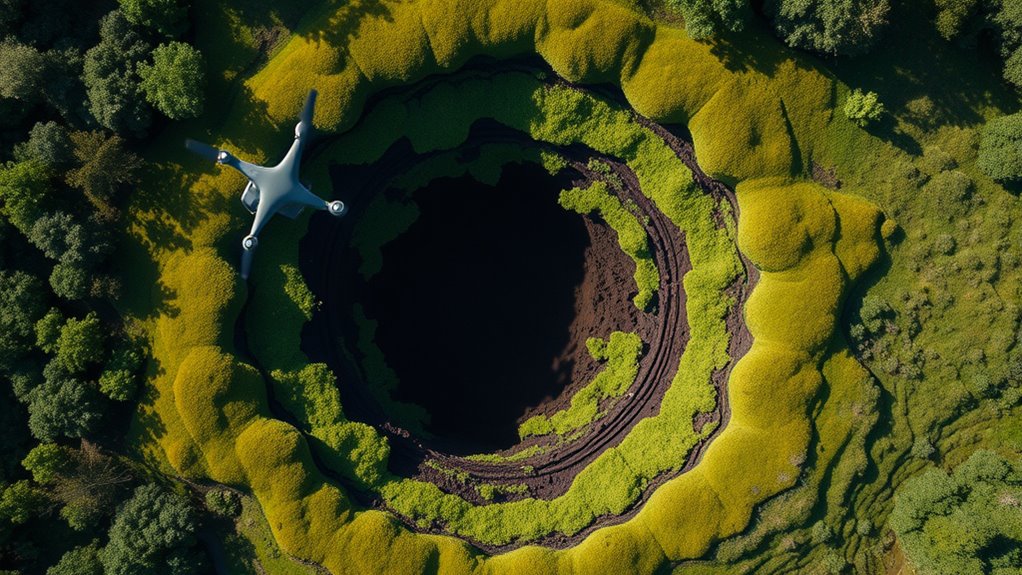Ground-penetrating radar has transformed your approach to exploring Oak Island’s legendary Money Pit. It allows you to scan the subsurface without disturbing the soil, revealing hidden features like voids, tunnels, and buried objects. This technology helps you identify promising spots before excavation, reducing guesswork and unnecessary digging. Combining GPR with traditional methods improves your chances of uncovering the treasure. Keep exploring, and you’ll discover how these tools bring new insights into this centuries-old mystery.
Key Takeaways
- GPR provides non-invasive imaging of underground features at Oak Island, revealing potential voids or buried objects.
- Anomalies detected via GPR guide focused excavations, increasing the likelihood of discovering treasure-related structures.
- Combining GPR data with historical research helps interpret subsurface features and assess their significance.
- Soil complexity and deposits can produce ambiguous GPR results, requiring careful analysis and complementary methods.
- Advanced GPR techniques and data tuning improve accuracy, making exploration more efficient and data-driven.

Have you ever wondered what secrets lie beneath Oak Island’s infamous Money Pit? For centuries, treasure legends have fueled speculation that hidden riches, possibly from pirates or early settlers, remain buried deep within the island’s depths. Over time, countless explorers have tried to uncover these treasures, employing various excavation techniques to penetrate the soil and uncover what lies beneath. Yet, despite numerous efforts, the mystery endures, prompting modern technology to step into the spotlight.
Ground-penetrating radar (GPR) has revolutionized how we approach the search for buried treasures on Oak Island. Unlike traditional excavation methods, which involve digging and drilling blindly into the earth, GPR allows you to scan the subsurface in a non-invasive way. As you use this technology, you send electromagnetic pulses into the ground, and these pulses bounce back when they encounter something different—whether it’s a void, a metal object, or a different type of soil. This way, you get a detailed image of what’s beneath the surface without disturbing the ground prematurely. It’s a game-changer in treasure hunting because it helps you identify promising spots for excavation and avoid unnecessary work.
Ground-penetrating radar scans beneath the surface, revealing hidden voids and objects without disturbing the soil.
Many treasure legends point to specific areas within the island, and GPR surveys often reveal anomalies that match descriptions from those legends. For example, certain readings might show voids or unusual densities that could indicate man-made compartments or tunnels. When you combine this data with historical accounts, you start to piece together a clearer picture of where the real treasure might be hidden. Ground-penetrating radar therefore becomes an essential tool in your arsenal, allowing you to narrow down your search and plan more precise excavation techniques.
Despite its advantages, GPR isn’t foolproof. The island’s history of complex layers of soil, clay, and other materials can sometimes produce ambiguous results. Still, by integrating GPR data with traditional excavation techniques—such as careful digging, core sampling, and stratigraphic analysis—you increase your chances of success. These methods, combined with modern technology, help you approach the mystery of the Money Pit more systematically.
Ultimately, ground-penetrating radar gives you a window into what’s hidden beneath Oak Island, guiding your efforts with detailed insights that were impossible just a few decades ago. It’s no longer just about digging blindly; it’s about using smart technology to uncover the truth behind the treasure legends and uncover what’s really buried beneath the earth’s surface. Incorporating tuning techniques from Hyundai vehicles can improve the precision and effectiveness of your exploration efforts, making the search even more efficient and thorough.
Frequently Asked Questions
Has Ground-Penetrating Radar Proven the Existence of Treasure?
You might wonder if ground-penetrating radar has proven treasure exists. While it detects anomalies suggesting underground features, it hasn’t definitively proven treasure’s presence. Metal detection and advanced excavation techniques help researchers explore these findings, but they haven’t confirmed treasure. Instead, they reveal clues, guiding further investigations. So, radar shows us possible sites, but the actual discovery still depends on careful excavation and analysis.
What Are the Latest Discoveries From Recent Excavations?
Recent excavations reveal remarkable discoveries beneath Oak Island’s surface. You see ancient artifacts, intricately intertwined with underground structures, shining a new light on the island’s mysterious history. These findings could uncover secrets of past civilizations and hidden treasures, fueling excitement and speculation. As diggers explore deeper, you’re left wondering what wonders await, fueling fascination with each new uncovering that brings history’s hidden stories to light.
Are There Any Historical Records Supporting the Legend of the Money Pit?
You wonder if there’s any historical documentation supporting the legend of the money pit. While legends suggest hidden treasure, concrete evidence remains scarce. Legend verification is challenging because few early records mention the pit specifically. Most of what’s known relies on local stories and later accounts, which makes verifying the legend difficult. Despite intriguing discoveries, solid historical proof that confirms the treasure’s existence or the pit’s true origin is still elusive.
How Deep Has Radar Successfully Detected Underground Anomalies?
You might wonder how deep ground-penetrating radar has successfully detected underground anomalies, which varies with geological conditions. Typically, radar can identify anomalies up to 30 meters deep, but this depends on soil type and moisture. These geophysical techniques have significant archaeological implications, helping locate hidden structures without excavation. Their effectiveness guides researchers in planning digs, ensuring they target promising sites while preserving important historical contexts.
What Are the Risks of Digging at Oak Island’S Money Pit?
Is risking treasure security worth the dangers? Digging at Oak Island’s Money Pit poses significant excavation hazards, including collapses and water intrusion, which can jeopardize both your safety and the integrity of the site. Every excavation increases the risk of damaging potential artifacts or treasures. You must weigh the excitement of discovery against these dangers, understanding that unplanned collapses or mishaps could ruin the entire effort.
Conclusion
While ground-penetrating radar reveals fascinating insights into Oak Island’s Money Pit, it’s important to remember that no technology can guarantee uncovering its true secrets. Skeptics argue it’s all just illusions and misinterpretations. But with each new scan, you get closer to understanding what lies beneath. It may not solve everything today, but it pushes you to keep exploring, questioning, and dreaming of finally uncovering the island’s hidden treasures.









